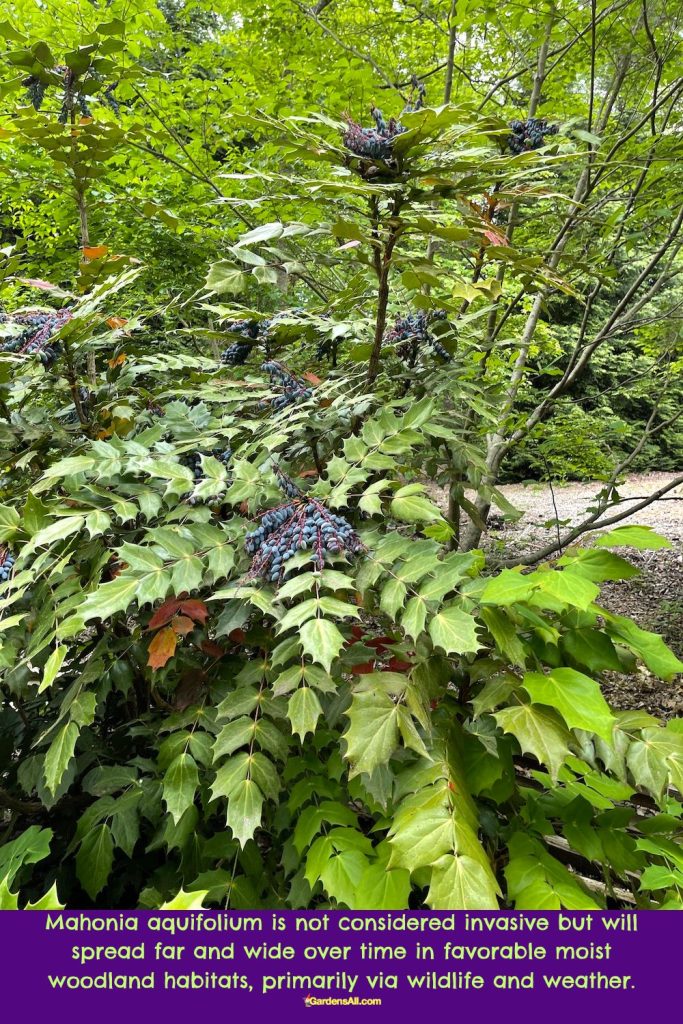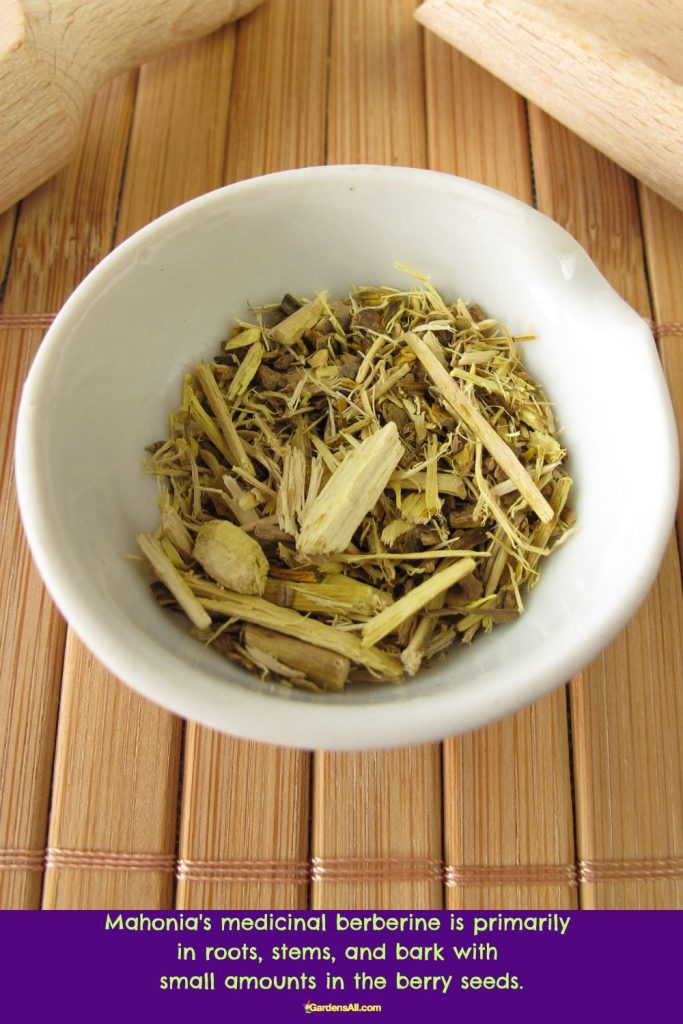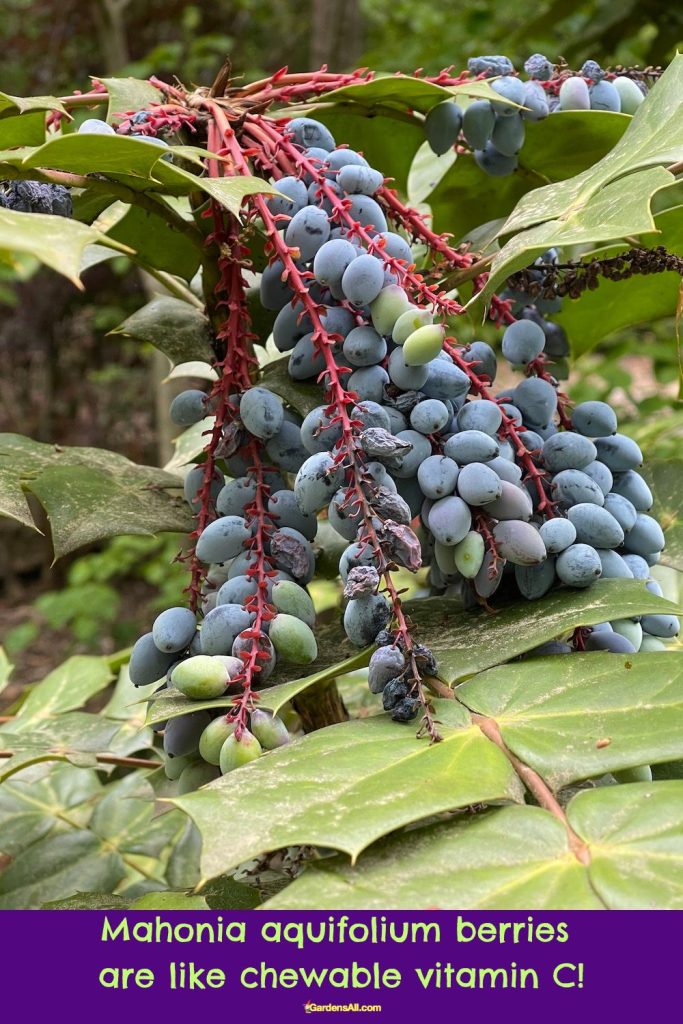History and Origin of Mahonia Aquifolium
Mahonia aquifolium, commonly known as Oregon grape, is native to western North America, and from British Columbia to northern California. This M. aquifolium grows in USDA hardiness zones 5-8, but there are other varieties that grow in
The Mahonia aquifolium plant, is a low maintenance, fast-growing evergreen shrub with attractive qualities for all-season ornamental interest. This Oregon grape shrub has a long history of edible and medicinal use and is high in the alkaloid compound berberine.
Ornamental and Medicinal Edible Hedge
Oregon Grape is a popular landscaping plant due to its attractive foliage and bright yellow flowers, and it is drought tolerant and low maintenance once established.
Mahonia aquifolium can serve well as an attractive and beneficial edible hedge with nutritive and medicinal benefits.
Mahonia Aquifolium Uses
- Medicinal: Mahonia root contains the alkaloid compound berberine, which has been shown to have antibacterial and anti-inflammatory properties. It has been used to treat a variety of ailments, including skin conditions, digestive problems, and infections.
- Culinary: The berries of the Oregon Grape plant are edible and can be used to make jams, jellies, pies and smoothies, or eaten raw. They have a tart, slightly bitter flavor, but with hints of sweet as they reach maximum ripeness. Mahonia berries are really high in vitamin C, and mahonia berry seeds are roasted for use as a coffee substitute.
- Ornamental: Mahonia aquifolium is a popular landscaping plant due to its attractive foliage and bright yellow flowers in the spring. It can be used as a hedge or as a specimen plant in a garden.
- Wildlife: Pollinators love the beautiful yellow flowers, and birds will eat the berries.
Traditional Health Uses of Mahonia
Parts of mahonia, especially the seeds and roots, were traditionally used by indigenous tribes for various medicinal purposes, including treating skin disorders, digestive problems, and as a general tonic. European settlers adopted the plant for medicinal use in the 19th century.
Is Mahonia aquifolium Invasive?
Mahonia aquifolium, also known as Oregon Grape, is not considered invasive in its native range in western North America. Some consider it so, but is native blackberry invasive…? It grows everywhere to, so while it can proliferate an area after a decade thanks to wildlife, prolific doesn’t automatically categorize something as invasive.
However, in some areas outside of its Mahonia’s native range, such as in parts of Europe, it has been reported as invasive. So before introducing new wild-cultivated plants it’s a good idea to check with your local extension service website or office to ensure it is not considered invasive in your area.
Additionally, like with any plant, it helps to monitor its growth and remove any unwanted seedlings to prevent it from spreading beyond where you want it to be. That said, wildlife doesn’t recognize boundaries.
We introduced Mahonia to our yard in a small 40 acre subdivision ~30 years ago and now we see mahonia shrubs of all sizes through the 40 acres, (and thus likely beyond as well.
Mahonia is not generally considered invasive but will spread far and wide over time in favorable moist woodland habitats, primarily via wildlife and weather.

Taxonomy and Common Names:
- Kingdom: Plantae
- Order: Ranunculales
- Family: Berberidaceae
- Genus: Mahonia
- Species: Mahonia aquifolium
- Common Names:
- Oregon Grape
- Holly-leaved Barberry
- Holly Mahonia
- Mountain Grape
- Oregon Grape Holly
Growing Information:
- Oregon Grape is an evergreen shrub that can grow up to 6 feet tall and 10 feet wide.
- It prefers well-drained soil and partial to full shade.
- It can be propagated by seed, stem cuttings, or division.
- It is drought tolerant and low maintenance once established.
Mahonia Varieties
There are several types of Mahonia plants, including:
1. Mahonia aquifolium (Oregon Grape)
- Common Names: Oregon Grape, Holly-leaved Barberry, Mountain Grape, Oregon Grapeholly, Holly Mahonia
- Description: Evergreen shrub with holly-like leaves and clusters of bright yellow flowers in the spring. The fruit is a blue-black berry with a tart, slightly bitter flavor.
- Habitat: Native to western North America, from British Columbia to northern California, and is commonly found in forests, meadows and along the edges of wooded areas.
- Edible fruit: The berries are edible and can be used to make jams, jellies, and pies. Can also be eaten raw and in smoothies. The seeds can also be consumed, although
- Zones: 5-9
2. Mahonia bealei (Beale’s Barberry)
- Common Names: Japanese Mahonia, Hollygrape Mahonia
- Description: Evergreen shrub with compound leaves and clusters of yellow flowers in the winter. The fruit is a blue-black berry with a sweet flavor.
- Habitat: Native to China and is commonly found in forests and along streams.
- Fruit: Berries are edible raw or cooked and are used in Chinese cuisine and are typically made into pies, jelly and wine in the west.
- Zones: 6-9
3. Mahonia japonica (Japanese Mahonia)
- Common Names: Cascade Barberry, Longleaf Mahonia
- Description: Evergreen shrub with spiky leaves and clusters of yellow flowers in the winter. The fruit is a blue-black berry with a tart, slightly bitter flavor.
- Habitat: Native to Japan and China and is commonly found in forests and along streams.
- Edible fruit: The berries are edible and are used in Asian cuisine.
- Zones: 7-9
4. Mahonia nervosa (Longleaf Mahonia)
- Common Names: Cascade Barberry, Longleaf Mahonia
- Description: Evergreen shrub with long, narrow leaves and clusters of yellow flowers in the spring. The fruit is a blue-black berry with a tart, slightly bitter flavor.
- Habitat: Native to western North America, from British Columbia to northern California, and is commonly found in forests and along the edges of wooded streams and riverbanks.
- Edible fruit: Yes, the berries are edible and can be used to make jams, jellies, and smoothies.
- Zones: 5-8
Mahonia pinnatifolia (Cutleaf Mahonia)
- Common Names: Wavyleaf Mahonia
- Description: Evergreen shrub with deeply cut leaves and clusters of yellow flowers in the winter. The fruit is a blue-black berry with a tart, slightly bitter flavor.
- Habitat: Native to China and western North America, from British Columbia to northern California. M. Pinnatifolia is found in dry rocky slopes and open forests.
- Edible fruit: Berries are edible and are used in Chinese cuisine.
- Zones: 5-8
What Do Mahonia Berries Taste Like?
The berries of Mahonia plants are generally tart and some include a slightly bitter taste. For that reason many people prefer to make jams, jellies, and pies, rather than consume them raw.
However, I like to eat the ripest ones raw. Our Mahonia aquifolium are slightly tart but not bitter and when they are fully ripe and deep bluish purpose, similar to ripe blueberries, they have a hint of a sweetness and are only mildly tart.
Can You Eat Mahonia Seeds?
Yes, with caution and not in excess. Mahonia seeds are not harmful, but any potent food in large quantities can cause digestive issues, and it’s advisable to experiment with just a few the first time and gradually increase the quantity over time if more is desired.
All Mahonia species contain berberine, a medicinal alkaloid compound that is primarily found in the roots, stems, and bark of the plant. Some information will say that berberine is toxic, however, any medicine is toxic if consumed in large amounts.
The exact amount of berberine in the seeds of Mahonia berries depends on factors such as the maturity of the berries, growing conditions, and harvesting methods, and can also vary by variety.
There is limited information available on the specific amounts of berberine in the seeds of different Mahonia species. However, the amount of berberine in the berry seeds is generally considered to be low and is not likely to cause harm if consumed in small quantities.
If you are interested in using Mahonia berries in your cooking or for medicinal purposes, remember that medicines are administered in small doses. So as with medicinal herbs, they are naturally potent, so only small amounts are needed in order to impart their flavors and medicinal benefits.
The berberine in mahonia is primarily concentrated in the roots, stems, and bark of the plant with only small amounts in the berry seeds.

Popping Berries Instead of Pills
Just 1/2 cup (100 grams) of M. aquifolium berries contains approximately 90mg of vitamin C. That’s 100% of the vitamin C RDA for males (at 90mg) and 120% RDA for women (at 75mg).
REFERENCE: Harvard School of Public Health[1]https://www.hsph.harvard.edu/nutritionsource/vitamin-c/
I like to pop fresh Mahonia aquifolium berries like pills during harvest season for some morning vitamin C, including the seeds. I also add them to smoothies, seeds and all and they have not caused any problems.
The seeds are a large part of the content of the berries and are time consuming to remove. However, they’re relatively soft and can actually be chewed along with the berries for added fiber.
Others prefer to make jams, jellies and syrups, and will separate the seeds in the process. However, cooking destroys the vitamin C content at temps over 120°F, and jams typically include a lot of sugar.[2] … Continue reading
So if you’re interested in preserving the health Oregon grape benefits, you may want to try consuming them raw and in smoothies, but in small quantities. It’s always a good idea to start any new berry or wild edible slowly to be sure it suits you and without an adverse allergic or digestive reaction.
During spring, I nibble daily on the ripest Mahonia aquifolium berries. Once all or the majority are ripe and ready, I harvest and freeze them to doll out into smoothies, salads or just to pop a few to munch.
Mahonia aquifolium berries are like chewable vitamin C!

I’m LeAura Alderson, a garden, herb and plant enthusiast with a passion for discovering the many edible and medicinal benefits of the plants all around us, including the weeds! I’m a writer, editor and media publisher for our family of websites.
While I was certified in fitness and life coaching, I am NOT a health practitioner. However, I’m a lifelong health enthusiast, with a keen interest in healthy, organic foods and making home remedies and the content we share is from our own experience and usage as well as that extracted from scientific research so that you can explore further on your own.
Always seek the advice and guidance of your health practitioners first and foremost.
As a family we’re steadily expanding our gardening, experimentation and knowledge around all things gardening, edible landscaping, fresh organic foods and self sustainability with farming in our future. I also own and manage iCreateDaily.com, a site all about transformation through creation, and the power of positivity, optimism and mindset.
References
| ↑1 | https://www.hsph.harvard.edu/nutritionsource/vitamin-c/ |
|---|---|
| ↑2 | https://www.nutraceuticalbusinessreview.com/news/article_page/Degradation_of_vitamins_probiotics_and_other_active_ingredients_caused_by_exposure_to_heat_water_and_sunlight/145924#:~:text=Vitamin%20C%20begins%20to%20denature,of%20Scientific%20and%20Technology%20Research.&text=The%20negative%20effects%20of%20heat,more%20at%20170%20%C2%B0F. |

